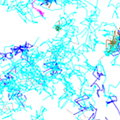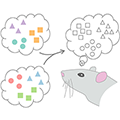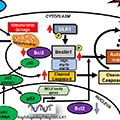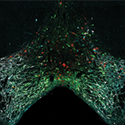Hot Off the Press – February 9, 2021 A receptor called the sigma-1 receptor, which was discovered at NIDA IRP, plays an important role in regulating the cargo transport between the cellular nucleus and cytoplasm that is dysfunctional in neurodegenerative diseases including amyotrophic lateral sclerosis (ALS) and frontotemporal dementia (FTD). The authors demonstrate and validate… [Read More]
News Main
Novel Fluorescent Ligands Enable Single-Molecule Localization Microscopy of the Dopamine Transporter
Featured Paper of the Month – February 2021
Published in ACS Chemical Neuroscience by Guthrie, Daryl A; Herenbrink, Carmen Klein; Lycas, Matthew Domenic; Ku, Therese; Bonifazi, Alessandro; DeVree, Brian T; Mathiasen, Signe; Javitch, Jonathan A; Grimm, Jonathan B; Lavis, Luke; Gether, Ulrik; Newman, Amy Hauck
The dopamine transporter (DAT) functions to control dopaminergic neurotransmission and is a target for therapeutic agents, including ADHD medications, as well as abused substances, such as cocaine. Here, we develop new fluorescently labeled ligands as promising new tools for studying DAT localization and regulation with single-molecule resolution…
2021 NIDA IRP FARE Winners
Congratulations to our 2021 FARE (Fellows Award for Research Excellence) winners: Harsh Deshpande, Ewa Galaj, Evan Hart, Therese Ku, Brenton Laing, Renata Marchette, Adrienne McGinn, Jorge Miranda Barrientos, and David Reiner. They will each receive a $1500 travel stipend to attend a scientific meeting to present their research and gave a talk at the virtual… [Read More]
Evolving schema representations in orbitofrontal ensembles during learning
Hot Off the Press – January 3, 2021 Learning what to learn about and generalizing from one situation to another is arguably one of the most fundamental abilities that distinguishes higher intelligence. The effects of the resultant schemas can be seen in simple motor or sensory processing, in which learning one skill facilitates acquisition of… [Read More]
Compulsive methamphetamine taking induces autophagic and apoptotic markers in the rat dorsal striatum
Featured Paper of the Month – January 2021
Published in Archives of Toxicology by Subu, Rajeev; Jayanthi, Subramaniam; Cadet, Jean Lud
The use of methamphetamine (METH) is very prevalent throughout the world. METH can cause anxiety, psychosis, seizures, and death. Previous research in the Cadet Lab has shown that METH can cause neurodegeneration when the drug is injected by investigators. It was therefore important to find out if there is degeneration in the brains of rats that learn to give themselves METH by a behavioral technique called self-administration (SA)…
Long-Term Cocaine Self-administration Produces Structural Brain Changes That Correlate With Altered Cognition
Hot Off the Press – December 21, 2020 This paper used longitudinal imaging and neurocognitive assessments in matched experimental and control macaque monkeys to study changes following chronic cocaine self-administration and extended abstinence. True baseline measures prior to any cocaine exposure, something not available in clinical cross-sectional comparisons, permitted a determination of changes in structure… [Read More]
Exception That Proves the Rule: Investigation of Privileged Stereochemistry in Designing Dopamine D3R Bitopic Agonists
Featured Paper of the Month – December 2020
Published in ACS Medicinal Chemistry Letters by Battiti, Francisco O; Newman, Amy Hauck; Bonifazi, Alessandro
In this study, starting from our highly selective and potent D3R agonist 5 , we further investigated the chemical space around the linker portion of the molecule, via insertion of a hydroxyl substituent and ring-expansion of the trans cyclopropyl moiety into a trans -cyclohexyl scaffold…
Distinct Signaling by Ventral Tegmental Area Glutamate, GABA, and Combinatorial Glutamate-GABA Neurons in Motivated Behavior
Hot Off the Press – November 23 , 2020 The Ventral tegmental area (VTA) is best known for containing dopamine neurons that play a role in motivated behavior. However, we had previously demonstrated that the VTA has neurons that co-transmit glutamate and GABA, neurons that transmit glutamate without GABA, and neurons that transmit GABA without… [Read More]
Processing in Lateral Orbitofrontal Cortex Is Required to Estimate Subjective Preference during Initial, but Not Established, Economic Choice
Hot Off the Press – November 23 , 2020 Adaptive decision making requires us to imagine – or mentally simulate – potential outcomes, particularly when potential outcomes are far off, uncertain, or even anecdotal. This ability depends in part on the orbitofrontal cortex (OFC) , an important part of the frontal lobe altered in addiction…. [Read More]
Jingfeng Zhou, Ph.D. Has Received the NIH Pathway to Independence Grant Award
Dr. Zhou is currently a postdoctoral fellow in the lab of Dr. Geoffrey Schoenbaum at the NIDA IRP where he studies neural circuit mechanisms of animal behavior and cognition. Using in vivo electrophysiology as a primary tool, his research attempts to map neural dynamics embedded in the neural population activities to the hidden cognitive variables… [Read More]










